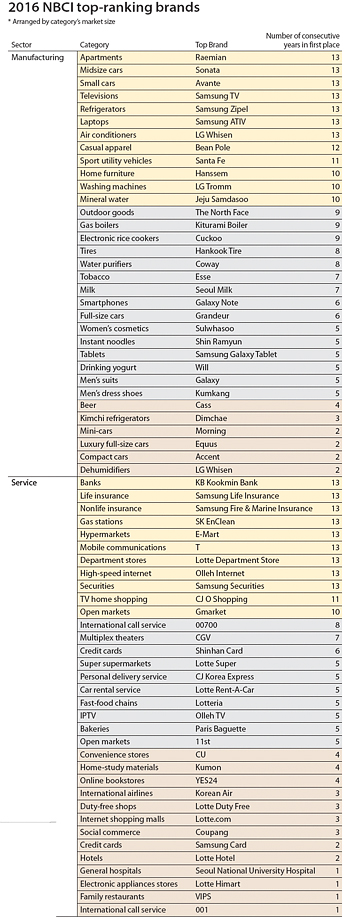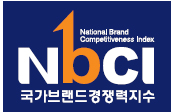[Sponsored Report] NBCI measures local brands’ competitiveness

The Korea Productivity Center calculated the NBCI of 232 brands in 64 categories over one year. The average NBCI score, which measures the overall competitiveness of local brands, stood at 73.5 points, a 1.7 percent increase year-on-year.
The 64 categories were largely divided into the manufacturing and service sectors.
In the manufacturing sector, 117 brands in 33 categories were evaluated. Overall, the sector scored an NBCI average of 73.8 points, a 1.5 point increase from last year. The category for televisions had the highest NBCI average, with 79 points, followed by luxury full-size cars (77), tablets (77), gas boilers (75), home furniture (75), kimchi refrigerators (75), men’s suits (75), washing machines (75), smartphones (75) and air conditioners (75).
The increase in manufacturing was driven by categories such as outdoor goods, smartphones and midsize cars, stemming from newly-launched products customized to customers’ needs, reinforced brand marketing activities and newly-released vehicles.
The service sector, which included 31 categories and 115 brands, saw similar results. The sector’s average NBCI score was 73.2, a 0.8 point increase from last year. The top categories were duty-free shops (78), social commerce (76), mobile communications (76), international call services (75), car rental services (75), bakeries (75), open markets (75), electronic appliances stores (75), family restaurants (75), convenience stores (75) and TV home shopping (75).
The increase in the service sector was led by securities, social commerce and convenience stores, thanks to the expanding influence of online shopping and new products catering to single-person households.
Out of 63 categories surveyed last year, 46 saw their average NBCI score increase this year. Eleven categories, including instant noodles, credit cards, open markets and tablets had no change, and six saw their average score decrease, including banks, nonlife insurance companies, hypermarkets and bakeries.
The NBCI score of last year’s top two manufacturing brands saw an average increase of 1.1 percent, while those of brands below the top two saw a 3 percent average increase.
As for service sector brands, those in the middle of rankings saw the highest NBCI score increase. The NBCI score for the brand ranked first saw a 0.8 percent increase, those ranked second to fourth saw an average 1.3 percent increase and those ranked fifth to sixth saw an average 0.1 percent rise.

The National Brand Competitiveness Index (NBCI), released by the Korea Productivity Center, measures brand performance. It aims to support strategic management of domestic brands by calculating their competitiveness from a consumer’s perspective and using standardized evaluation criteria for competing brands to compare and benchmark each other.
By surveying consumers on the brand’s products, services and management, the NBCI model calculates how perceived brand awareness, brand image and brand relationship affect intent to purchase and brand competitiveness.
Unlike other models done from a marketing perspective, which only regard brand awareness and brand image as the main influences of brand competitiveness, the NBCI model also considers marketing activities as well from a theoretical basis. The NBCI model has passed through statistical tests to raise its degree of accuracy.










with the Korea JoongAng Daily
To write comments, please log in to one of the accounts.
Standards Board Policy (0/250자)